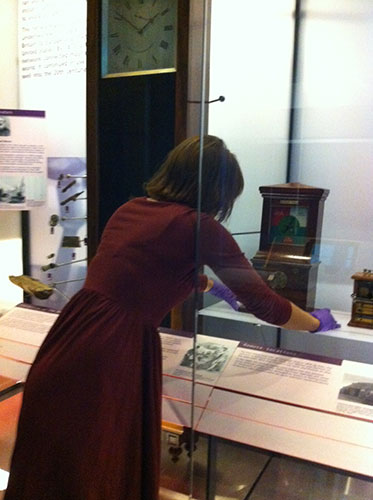If I were to summarise my time at the National Museum of Scotland with one phrase, and I make no attempt to avoid clichés, there is much much more than meets the eye. The Science and Technology department was my base for a five week work placement, where I was hoping to achieve a general feel for what the day to day working life of a curator involved. Alison Taubman, Principle Curator of Communications and my main contact at the museum, as well as the rest of the department, quickly made me feel at home – particularly over the morning coffee/gossip!
My first week was spent generally getting a feel for the place by meeting other members of staff and departments and trying not to get lost in the rabbit warren of stairs, offices and corridors behind the scenes. I was primarily assisting the curators on plans for new Science and Technology galleries due to open in 2016 and it has been fascinating, if not slightly daunting, to see the amount of work and issues that arise when attempting such a huge project.

Every Monday afternoon was spent with Dorothy Kidd at the department of Scottish History and Archaeology. Here I sorted through and archived a huge selection of photos linked to Lochee Nursery and Ancrum Road School, Dundee. Many of the photos and documents appeared to be donated by a particular family in the area – it was amazing seeing the whole family history laid out in front of me marked by births, weddings and deaths as well as a number of family holidays. They were all dated from the early 1910s to 1940s so were a fascinating insight into a way of life now very different from my own.

Over the course of my time at the museum I made several trips to the National Museums Collection Centre in Granton, a treasure trove of objects often bizarre and mysterious. The rooms filled with huge machinery, another with bones and another with rows and rows of bicycles were a joy just to wander around. Here I assisted by measuring and taking objects to the Photography and Conservation departments, a process much more time-consuming than I ever expected. The sheer size of not just the whole collections but some of the objects meant a lot of time was just spent moving or searching for items somewhere in the series of shelves and rooms that make up the museum stores. At one point we unearthed a beautiful original drawing of a beam engine by Boulton and Watt from 1786 not seen for years! Another day was spent assisting a crew filming an object created by the art collective Found for Durer’s whiskey – it seems the draw of the museum stores is universal.

One particular highlight was a departmental trip to Stanley Mills, an 18th century textile mill in Perthshire. I drove up to Stanley Mills with Alex Hayward, Klaus Staubermann and Emma Webb from Learning and Programmes to look at their impressive array of interactive exhibits for inspiration with regards to future displays. The museum did indeed have a great number and variety of interactive displays. This included a series of games to give children a feel for the concentration, quick reflexes and the tedium involved in working at the mill and interactives to divert water flows to manipulate different styles of waterwheels, ideas that we would hope to draw on as the plans for the new galleries develop. The day was topped off by a visit to Stewart Tower dairy for lunch and giant ice creams all round – if only this could happen every week!

To get as broad an overview of the different work involved in running the museum as possible I spent some of my time among other departments. On one afternoon I helped carry out visitor consultations for Scotinform to gather data and opinions on the plans for the new galleries. This was an excellent reminder that a museum is as much for public engagement as it is about collecting and preserving and research. More time was also spent in the Development and Marketing and Communications departments, helping with museum events – yet another aspect of backstage museum life I had failed to consider.
Over the past five weeks I definitely feel I’ve started to grasp the complexities of museum life and the work involved for the curators here. I thank Alison and the team for making me feel so welcome and my time so enjoyable. I now can’t wait to come and visit the museum once the new galleries are up and running!